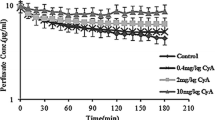Summary
The effect of pretreatment with cyclophosphamide 180 mg/kg upon the short-term disposition of adriamycin in anesthetized rat 4 days later was studied. There was a significant decrease in plasma adriamycin clearance, from 125 to 48 ml/min/kg, and a significant decrease in the apparent volume of the peripheral compartment of adriamycin distribution, from 51.7 to 25.6 l/kg, in cyclophosphamide-pretreated as against control rats. Biliary excretion of adriamycin over 2.5 h was increased significantly by 114% in cyclophosphamide-pretreated rats and there was a small but nonsignificant increase in biliary adriamycinol excretion and a decrease in excretion of adriamycin aglycones. Cyclophosphamide pretreatment was associated with an 83% increase in bile flow. Cyclophosphamide pretreatment had no significant effect upon the utilization of adriamycin or upon the formation of adriamycin metabolites by rat isolated hepatocytes. The results suggest that NADPH-cytochrome P-450 reductase, which is decreased 40% by cyclophosphamide pretreatment, is not rate-limiting in elimination of adriamycin. Biliary excretion of adriamycin is increased when plasma adriamycin clearance is decreased, suggesting that cyclophosphamide pretreatment affects a pathway besides biliary excretion that is responsible for the short-term removal of adriamycin from plasma.
Similar content being viewed by others
References
Andrews PA, Brenner DE, Chan FTE, Kubo Hk, Bachur NR (1980) Facile and definitive determination of human adriamycin and daunorubicin metabolites by high-pressure liquid chromatography. Drug Metab Dispos 8: 152
Bachur NR (1979) Anthracycline antibiotic pharmacology and metabolism. Cancer Treat Rep 63: 817
Bachur NR, Gordon SL, Gee MV, Kon H (1979) NADPH-cytochrome P-450 reductase activation of quinone anticancer agents to free radicals. Proc Natl Acad Sci USA 76: 954
Baurain R, Deprez-DeCampaneere D, Trouet A (1979) Rapid determination of doxorubicin and its fluorescent metabolites by high-pressure liquid chromatography. Anal Biochem 94: 112
Broggini M, Colombo T, Martini A, Danelli MG (1980) Studies on the comparative distributions and biliary excretion of doxorubicin and 4′-epi-doxorubicin in mice and rats. Cancer Treat Rep 64: 897
Corbett TH, Griswold DP, Mayo JG, Laster WR, Schabel FM (1975) Cyclophosphamide-adriamycin combination chemotherapy of transplantable murine tumors. Cancer Res 35: 1568
Davis HL, Davis TL (1979) Daunorubicin and adriamycin in cancer treatment: An analysis of their roles and limitations. Cancer Treat Rep 63: 809
Driscoll JS, Hazard GF, Wood HB, Goldin A (1974) Structure-antitumor activity relationships among quinone derivatives. Cancer Chemother Rep [2] 4: 1
Eksborg S, Ehrsson H, Andersson I (1979) Reversed-phase liquid chromatographic determination of plasma levels of adriamycin and adriamycinol. J Chromatogr 164: 479
Evans WE, Crom WR, Yee GC, Green AA, Hayes A, Partt CB, Avery TL (1980) Adriamycin pharmacokinetics in children. Proc Am Assoc Cancer Res 21: 176
Gibaldi M, Perrier D (1975) In: Pharmacokinetics. Marcel Dekker, New York, pp 45–128 and pp 293–300
Gurtoo HL, Gessner T, Culliton P (1976) Studies of the effects of cyclophosphamide, vincristine, and prednisone on some hepatic oxidations and conjugations. Cancer Treat Rep 60: 1285
Israel M, Wilkinson PM, Pegg WJ, Frei E (1978) Hepatobiliary metabolism and excretion of adriamycin and N-trifluoroacetyl adriamycin-14-valerate in the rat. Cancer Res 38: 365
Klassen CD (1971) Studies on the increased biliary flow produced by phenobarbital in rats. J Pharmacol Exp Ther 176: 743–751
Marinello AJ, Berrigan MJ, Struck RF, Guengerich FP, Gurtoo HL (1981) Inhibition of NADPH-cytochrome P-450 reductase by cyclophosphamide and its metabolites. Biochem Biophys Res Commun 99: 399
Metzler CM, Elfring GL, McEwen AJ (1974) A package of computer programs for pharmacokinetic modeling. Biometrics 30: 562
Morgan LR, Hagardorn AN, Maddux B, Sutherland C, Carter RB, Krementz ET (1976) Pharmacology of weekly low-dose adriamycin in human breast cancer. Pharmacologist 18: 126
Muggia FM, Perloff M, Chia GA, Reed LJ, Escher GC (1974) Adriamycin (NSC-123127) in combination with cyclophosphamide (NSC-26271): A phase I and II evaluation. Cancer Chemother Rep 58: 919
Powis G, Svingen BA, Degraw C (1982) Iron-EDTA stimulated reduction of indicine N-oxide by the hepatic microsomal fraction, isolated hepatocytes, and the intact rat. Biochem Pharmacol 31: 293
Reich SD (1978) Clinical correlations of adriamycin pharmacology. Pharmacol Ther [C] 2: 239
Riggs CE, Benjamin RS, Serpick AA, Bachur NR (1977) Biliary disposition of adriamycin. Clin Pharmacol Ther 22: 234
Shinozawa S, Oda T (1981) Determination of adriamycin (doxorubicin) and related fluorescent compounds in rat lymph and gall by high-performance liquid chromatography. J Chromatogr 212: 323
Snedecor GW, Cochran WG (1976) Statistical methods, 6th edn. Iowa State University Press, Ames, p 59
Stewart AJ, Inaba T (1979) N-Demethylation of aminopyrine in vivo and in the isolated hepatocyte of the rat. Biochem Pharmacol 28: 461
Takanashi S, Bachur NR (1976) Adriamycin metabolism in man. Evidence from urinary metabolites. Drug Metab Dispos 4: 79
Tavoloni N, Guarino AM (1980a) Bile secretory function: A determinant of adriamycin disposition. Arch Int Pharmacodyn 245: 180
Tavoloni N, Guarino AM (1980b) Biliary and urinary excretion of adriamycin in anesthetized rats. Pharmacology 20: 256
Wilkinson PM, Mawer GE (1974) The persistence of adriamycin in man and rat. Br J Clin Pharmacol 1: 241
Wilkinson PM, Israel M, Pegg WJ, Frei E (1979) Comparative metabolism and excretion of adriamycin in man, monkey, and rat. Cancer Chemother Pharmacol 2: 241
Williams BA, Tritton TR (1981) Photoinactivation of anthracyclines. Photochem Photobiol 34: 131
Yasukochi Y, Masters BSS (1976) Some properties of a detergent-solubilized NADPH-cytochrome c (cytochrome P-450) reductase purified by biospecific affinity chromatography. J Biol Chem 251: 5337
Yesair DW, Schwarztbach E, Schuck D, Denine EP, Asbell MA (1972) Comparative pharmacokinetics of daunomycin and adriamycin in several animal species. Cancer Res 32: 1177
Author information
Authors and Affiliations
Rights and permissions
About this article
Cite this article
Hartman, N., Basseches, P.J. & Powis, G. Effect of cyclophosphamide pretreatment on the short-term disposition and biliary excretion of adriamycin metabolites in rat. Cancer Chemother. Pharmacol. 10, 11–15 (1982). https://doi.org/10.1007/BF00257229
Received:
Accepted:
Issue Date:
DOI: https://doi.org/10.1007/BF00257229



